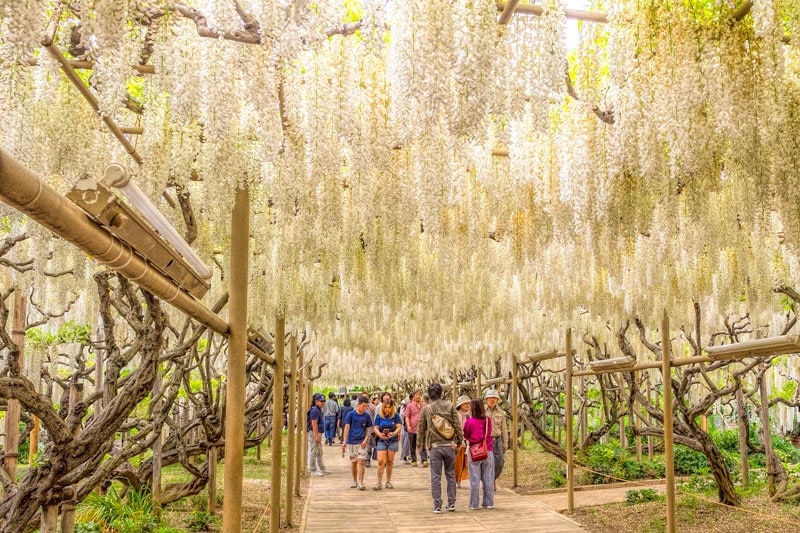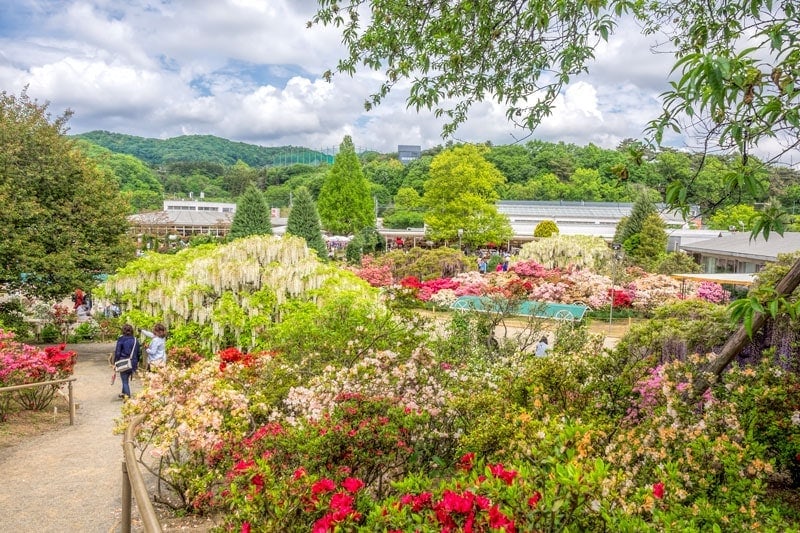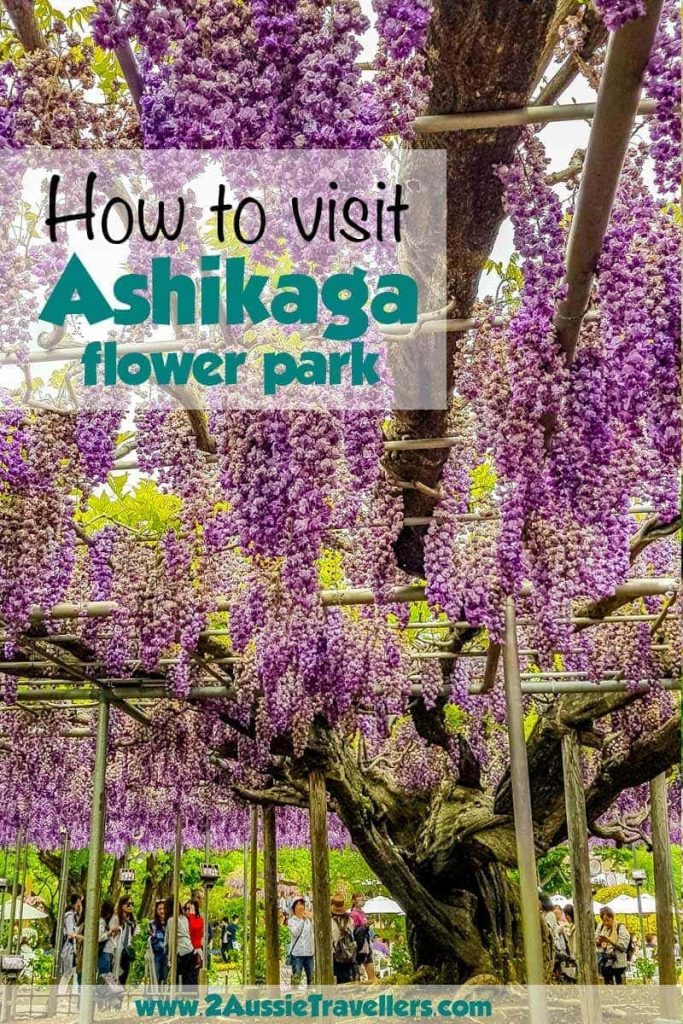
When we started planning a late spring trip I knew that catching the wisteria in Japan in their spectacular bloom would be a priority. We’ve seen the majestic pagodas covered in vines both bare in winter and early spring and in vibrant green leaf through summer but we’ve never caught sight of a single wisteria bloom in all these years travelling in Japan. Add to that many will tell you some of the worlds best wisteria displays are seen in Japan at Ashikaga Flower Park in Tochigi Prefecture, an easy day trip from Tokyo, and I was sold.
I’ve written here before about our picks of the best gardens to visit in Japan and this one is joining the list. It’s very different to many, not the traditional style we normally favour, but very beautiful and a true seasonal garden where one blooming flows into the next. When we visited the cherry blossom and spring bulbs had just ended, the azaleas and wisteria were showing the full force of their beauty and we could just see the first few tentative roses coming into their showy bud burst.
Nature has a way of being unpredictable with its timing and wisteria blooms are no exception but we made this trip on the 6th of May and managed to hit a good point. The pink bloom first, then the blue and white followed by the yellow so that does increase your chances of hitting a good display. We were slightly behind peak flower on the blue but they were still good and the white and pink were spectacular. Mid-April to mid-May is considered the season for wisteria in Japan and within that zone, it will depend on the year. This is the time when the wisteria festival called Fuji no Hanamonogatari takes place at Ashikaga flower park.
Table of Contents
Getting to the Ashikaga Flower Park from Tokyo
A trip to Tochigi Prefecture to visit the Ashikaga flower park makes a great day trip from Tokyo. We travelled with Tobu Railways from Asakusa using the seasonal Spring Flower Tour Ticket set but this can be done with individual tickets too.
The tour ticket set has four parts and they are labelled as 1/4 to 4/4 for simplicity. The first is your return train ticket from Asakusa, the second is the shuttle bus to the park, the third is the flower park ticket and the 4th is the return shuttle bus ticket.

There are a couple of direct trains each day taking around an hour and a quarter to reach Ashikaga-shi station. As with all long-distance trains in Japan you can take food and drink onboard. There’s a really good 7-eleven opposite the entrance to the station in Asakusa so we picked up some snacks for the trip from there. It’s a bit of a train travel ritual for us, clearly not essential on a trip that length but a fun way to find some new favourites from the convenience store. Even after this many trips I still find it bizarre that a 7-eleven is such as different store to what it is at home, another benefit of an early morning start is that the shelves are crammed full of all that day’s fresh offerings. The bakery selection is great but the spicy cod roe (mentaiko) onigiri are my favourite.
If you are doing the return trip on the Ryomo limited express train (which is faster but only runs a couple of times a day) you will have two additional tickets with car and seat numbers shown on them in English. Limited Express trains in Japan, whether Tobu, JR or another train company require you to have a seat booked and will require 2 tickets, one is the usual train ticket and other your reserved seat allocation. Once through the turnstiles, there was someone waiting by the Ryomo train to check your tickets and help out if you need it.
Similar to the Tobu Railway trains we’ve taken previously to Kinugawa Onsen and Nikko there was plenty of space to stretch out, get your bags out of the way and set up. It’s a pretty part of the countryside once out of the city limits so I spent most of the time watching the landscape change outside my window and almost missed our stop so do keep an eye on the board above the door or listen to the announcements which are in both Japanese and English.
Exit the train at Ashikaga-shi station. As you leave through the gate there are toilet facilities straight ahead but you want to head to the right and cross the road at the crossing. On the far side, there’s a bus stop and that’s the one you want to the Ashikaga Flower Park. The bus meets the train so it was already there waiting when we arrived. When you arrive at the park the bus stops in an area near the gardens but not in the main carpark so you need to cross the road and follow the path towards the hills, it’s not far but might not be immediately obvious either.
Ashikaga Flower Park

Hand over your ticket at the entrance and go in. We had our ticket as part of the Tobu package but if you are going out of season you can pay at the gate on your way in. I knew immediately by the gorgeous wisteria they had blooming in the pots out front that this would be quite the show and I couldn’t wait to get started. You pass through the gift shop first, we had a quick look as we passed but knew we could stop and look there later when we were finished exploring the gardens. There’s a great selection of flower themed gifts, both food and personal items to take home as souvenirs, I love looking at the omiyage (travel gifts) as we move around Japan and there were a lot of unique options here.
Next, you come to the flower courtyard with the light pink wisteria trellis behind and the largest of the dining options, there’s the food terrace, restaurant and takeout corner. You can get the insta-famous wisteria ice-cream here and the delicious strawberry one but both are also available further into the gardens once the crowd has disbursed a bit. As with most Japanese gardens the paths are winding creating many options and vistas within the space and the scenery is borrowed from the hills on both sides of the garden surrounds.

From here the park is open to explore, following the paths in all directions. It is already 94,000 square metres but beyond I could see that the park will extend beyond the fenceline in years to come with robust new wisteria frameworks in place up on the hillside.
There are plenty of options to eat too, in addition to the main area near the entrance there was a cafe up on the hill where you could sit in or take food and drink outside to sit and eat enjoying the view of the garden. Then there is the Tochigi teahouse between the wisteria dome and western gate.
Wisteria in Japan

The Ashikaga Flower Park is diverse in its seasonal flowering but it’s known most of all for the 350+ Wisteria called fuji or with the honorific, Ofuji, in Japanese. Wisteria in Japan is an important symbol of the spring season, of renewal and new beginnings. As with the cherry blossom, it inspires gatherings of friends and families, all forms of art and even food and drinks during the short season.
The peak of the wisteria usual coincides with the azaleas, another common but striking flower in Japanese parks and gardens. They are seen here in the park as the paths wind up into the hillside.

The most renowned of the wisteria here is the huge central tree called ‘Oyodo of the Miracle’ that spans the walkway over the water. This tree was transplanted into the garden when it was already 130 years old by Konami Tsukamoto, a renowned female tree doctor in Japan. A signboard shows the various stages of the project, nothing of that scale had been attempted before and it was the first successful transplant of a giant mature specimen in Japan. This single tree now spans over 100 square metres.
Together this tree with 3 other giant wisterias (Ofuji) and the 80-metre long white wisteria (Shirato) tunnel are collectively counted at natural monuments of Tochigi Prefecture.
When do the wisteria bloom at Ashikaga Flower Park

In general wisteria in Tochigi and across much of Japan blooms from mid-April until Mid-May. When planning your trip it can be useful to know the more specific flowering pattern of the various types of wisteria.
The pink wisteria usually blooms first around mid-April lasting until late in the month, the soft pink flowers are reminiscent of the cotton candy pink of cherry blossom just as that season ends.
Next comes the deep purple-blue of the Great Wisteria from late April into early May. These giant old trees are supported by robust trellis sprawling up to 100 square metres and heavily laden with flowers.
The white wisteria blooms in early May and is ethereal in its beauty and simplicity. These white vines are throughout the garden but the 80-metre long tunnel near the main courtyard is particularly spectacular and a designated natural monument of Tochigi.

Finally, there is the golden (kibana) wisteria in bloom from early to mid-May. When we visited on the 6th there were only a couple of solitary flowers but the tunnel of yellow wisteria is the only one in Japan.
Other times of year to visit Ashikaga Flower Park
While the month-long wisteria festival is the most popular time of the year to visit the gardens they are popular for their events and flowerings all throughout the year attracting 1.5 million visitors a year. The year is divided into 8 distinct themes or garden seasons, these are:
- Early spring. During the winter months of January and February you’ll see the snow fences still in place to protect the plants. Deep red and fragrant plum blossoms hint at the arrival of spring along with many other small early flowers such as winter buttons and the climbing lowbye.
- Spring flower festival. From early-March until mid-April you’ll see the 20,000 tulips, golden rapeseed, baby’s breath (yukiyanagi) and cherry blossoms in flower.
- Wisteria festival. Mid-April until mid-May is the Wisteria festival and the azalea are a riot of colour too. This is the time that we visited but there are other seasons that would tempt me back. It really is an easy trip from Tokyo and garden-lovers are a friendly and happy community around the world so always a pleasure to spend time around others that enjoy the beauty of nature.
- Rainbow garden. From mid-May and into June the gardens are a riot of colour with the 1000 azaleas continuing to flower, 2500 rose and 500 clematis all clamouring for attention.
- Blue and white garden. Japanese gardeners adore the hydrangeas that flower through June and July and add to the blue theme of the iris growing alongside the canal. Late blooming clematis continues flowering through until October.
- Waterlillies. From late June until November 1,500 tropical waterlilies flower both day and night in colours of white, yellow, peach, red, purple and blue.
- Purple garden. As the autumn breezes begin in October, 300,000 amethyst sage flowers bloom alongside lantana and roses.
- Light flower garden. From the end of October until early February, flower fantasy is one of Japans top 3 illumination festivals with 4.5 million LED bulbs lighting up the garden. You can find more information about this winter event here.

Extending your day in and around Tochigi Prefecture
There are a variety of options from here to extend your day trip out from Tokyo, or even to stay a night or two in these surrounds.
Tochigi city
Carrying the same name as the prefecture, Tochigi is around 25 minutes by train from the Ashikaga Flower Park. It is set on a river and best known for the Kuranomachi area where you’ll find the centuries-old merchant warehouses, a great opportunity to take a stroll and soak up the old-town feel. Some of the warehouses have been converted into shops displaying the works of local artist and the Museum of Art is also here. If you want a longer walk head up the stone steps into the foothills of Mt Taihei to Ōhirasan Shrine, in autumn you’ll be surrounded by the jewel-coloured leaves and in summer this is a top spot to enjoy the hydrangeas in flower.
Tatabayashi
Another option is to come back as far as Tatebayashi in Gunma Prefecture, about 15 minutes by train from Ashikaga-shi station. There is a range of things to do here especially for those that are interested in adding more parks and gardens to your day. Top picks would be:
- Gunma Museum of Art hosts a permanent collection and a variety of special exhibitions throughout the year in its distinctive gallery. There is a sculptors studio and workshop on site where you can observe the creative process and a restaurant.
- Tobu Treasure Garden. This 80,000 square metre park boasts over 1 million plants. It is part of the Tobu Group and has some great seasonal highlights if you are in the area, the pink moss and baby blue eyes are dramatic in the spring, and they are also known for their display of roses throughout summer.
- Tsutsujigaoka Daini Park. These are a massive park and gardens and if you were in Ashikaga for the wisteria then there is a good chance that you will overlap with two festivals here, for childrens’ day the river is crisscrossed with hundreds of carp streamers flying in the breeze while families picnic alongside and the azalea festival should be in full bloom. The 11-hectare park has 10,000 azaleas planted in all colours of the rainbow including some really old wild azalea trees, one has been dated at over 800 years old.
Another option to consider as you’ll be finishing your day at Asakusa station is to explore this area in the late afternoon and evening. This is a fun area of Tokyo with so much to do, we always include it on our itineraries and have a guide to all the best things to do in Asakusa on the site.
Some final tips
We highly recommend getting out of the main cities and enjoying day trips to areas like Ashikaga, you’ll see another side of the country, there’s more open space, it’s relaxed and it’s a great opportunity to connect with the locals who are usually very welcoming of visitors with a shared interested in their area.
While we consistently find the Japanese people kind and extremely helpful, even with our very limited ability to communicate in Japanese. Any effort you can make is appreciated. We aren’t gifted with languages but try to add to our few Japanese words and phrases each trip and there are some very helpful apps now available that make travelling to these areas with less English signage and information even easier.
Google translate is one option that works well for translating signs but has well-known issues with voice. We have recently found a far better (and free) alternative is VoiceTra. You simply set the from and to language and then speak into the microphone and it translates it both in verbal and written form and it’s very accurate. We sat down and tested it out one evening in Osaka over dinner with a local and it enables quite a robust conversation.
While the number of hotspots in Japan is increasing it’s still likely you’ll benefit from having connectivity far more often than it is available for free. We’ve written a cheat sheet for working out your WIFI options when travelling in Japan but we have used and recommended WIFI2Go for Australian travellers for several years now. Despite travelling out into rural areas, hot spring towns, travelling on speeding trains and climbing the odd mountain we have maintained connectivity throughout. You get unlimited data and the price is competitive. They have even given our readers a discounted price of $8 per day if you mention 2 Aussie Travellers when you book.
Interested? Please save it to Pinterest for later.

